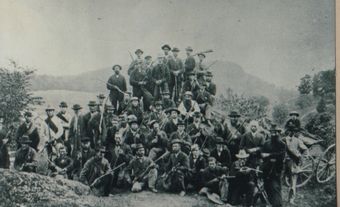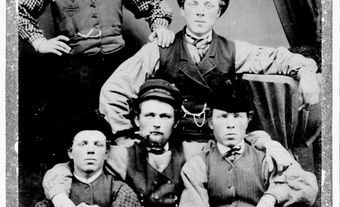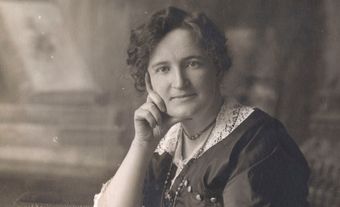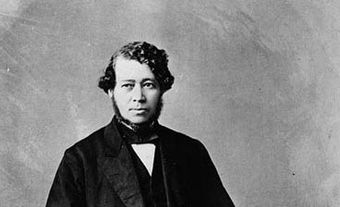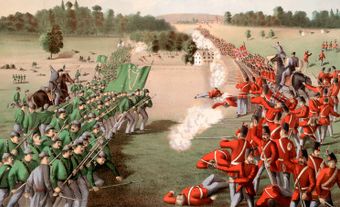The Fenians were a secret society of Irish patriots who had emigrated from Ireland to the United States. Some members of this movement tried to take Canadian territory by force, so they could exchange it with Britain for Irish independence. From 1866 to 1871, the Fenians launched several small, armed attacks. Each raid was put down by government forces. Dozens were killed and wounded on both sides. The raids revealed shortfalls in the leadership, structure and training of the Canadian militia, and led to improvements in these areas. The raids also took place at a time of growing concern over the threat posed by American military and economic might. This led to increased support for Confederation.

American Movement Grows
Fenians were members of a mid-19th century movement to secure Ireland’s independence from Britain. They were a secret, outlawed organization in the British Empire, where they were known as the Irish Republican Brotherhood. They operated freely and openly in the United States as the Fenian Brotherhood. Eventually, both wings became known as the Fenians.
John O’Mahony named the Fenians after the Fianna Eirionn, the ancient Irish warriors. The society suffered a blow in 1865; Britain crushed the Ireland-based independence movement, scattering its leaders. This situation left many Irish veterans of the American Civil War with considerable bad feelings towards Britain. Their membership in the Fenian movement quickly grew to around 10,000 men.
The Fenians’ main goal was Irish independence. But they were divided on how this could be achieved. Some advocated staging a massive uprising in Ireland. Others favoured cross-border military action against Britain’s North American colonies.
Did you know?
Fenians were both an external and internal threat. Recent scholarship reveals considerable support for Irish nationalism in Canada. The number of sworn Fenians was small — only 1,000 to 3,000 out of a population of approximately 250,000 Irish-Catholics in Canada. But many others were sympathetic to the cause. There were Fenian circles in all major urban areas, including Montreal and Toronto, and in some rural townships.

Fenians Target Canada
British and Canadian officials took the threat posed by the Fenians seriously. They ordered spies planted among Confederate sympathizers in the northern United States to shift their focus to the Fenians. Agents were sent to infiltrate Fenian organizations in Chicago, Detroit and Cincinnati. (See Gilbert McMicken.) In November 1865, a small number of militia were called out to garrison points in Canada West (modern-day Ontario), including Sarnia, Windsor, Niagara and Prescott.
By March 1866, it was clear that the Fenians were going to act against Canada. As a result, 10,000 Canadian volunteers were called up for active duty. This number was later increased to 14,000. However, nothing happened and the volunteers were sent home. In April, the Fenians staged a raid against Campobello Island in New Brunswick. The extent of the damage was a few destroyed buildings.
In May 1866, further evidence revealed another potential attack. The Fenians had ambitious plans to strike at several points in Canada West and Canada East (modern-day Quebec). Twenty-thousand Canadian volunteers were quickly mobilized along with 13 small steamboats. They patrolled the Great Lakes and the St. Lawrence River under the guidance of the Royal Navy. The Fenian plans fell apart because fewer men than expected joined the forces in Chicago, Cleveland, Buffalo and other locations. Also, Fenian leaders were unable to secure the ships needed to transport their forces. American officials, uneasy over how the invasion might affect Anglo–American relations, also intervened and made some arrests.
With their plan in tatters, the remaining Fenians considered the alternatives. They settled on crossing the Niagara River from Buffalo to Fort Erie in Canada West.

Battle of Ridgeway
On 1 June 1866, an advance party of 1,000 heavily armed Fenians crossed the Niagara River from Buffalo, New York. They were led by John O’Neill, a former US Calvary officer who had served in Ohio and West Virginia during the Civil War.
The Fenians quickly captured the undefended town of Fort Erie, Canada West, along with its railway and telegraph terminals. They arrested the town council and the customs and border officials at the international ferry docks. They forced the town’s bakery and hotels to provide them with food. After cutting outgoing telegraph lines, the insurgents seized horses and tools, which they used to build trenches and fortifications. They were within marching distance of the Welland Canal, the only navigable naval passage between Lake Ontario and Lake Erie.
Meanwhile, Major-General George T.C. Napier, the commander of British forces in Canada West, jumped into action. Some 22,000 militia volunteers were mobilized to respond to the Fenian incursion, along with several British infantry units stationed in Canada. Some 900 men from the 2nd (Queen’s Own Rifles) and 13th Battalions were sent to Dunville. They were joined by the York and Caledonia Rifle Companies, under the command of Lieutenant-Colonel Alfred Booker. Another column of troops, under British Lieutenant-Colonel George Peacocke, was en route to Chippawa, from where he would assume command of the British and Canadian troops. To contain the threat posed by the Fenians, Peacocke ordered Booker and around 850 men to Port Colborne. Booker was ordered to avoid the Fenians on his march to join the arriving column.

The Canadians were well deployed. They arrived in the vicinity of the Fenians within several hours of the incursion. But they were poorly trained and unprepared for combat. They had scarce ammunition, no food or field kitchens, no proper maps, no provisions for medical care, no canteens for water, and no tools for the proper care of their rifles. Only half of the troops had practiced firing their rifles with live ammunition. They were no match for the Fenians, who were well-armed and well-supplied veterans of the American Civil War.
On 2 June, Booker was ordered to move his troops to Fort Erie. Booker found 750 to 800 Fenians at Ridgeway and deployed his men, despite his orders to avoid contact. In the first hour of the battle, the Canadians appeared to prevail, driving Fenian skirmishers from their positions. Then something went wrong: to this day, it is not clear exactly what.
Contemporary sources reported that Canadian militiamen mistook Fenian scouts on horseback for cavalry (mounted soldiers). Booker’s order to form a square, designed to defend against a cavalry charge, exposed the Canadians to intense Fenian rifle fire. Booker quickly canceled the order. But he was unable to reform the inexperienced Canadian ranks now under intense and accurate fire. Other sources indicate that troops mistook a company of 13th Battalion infantry for British troops relieving them and began to withdraw; this triggered a panic among other troops who mistook the withdrawal for a retreat. Nine Canadians were killed and 32 were wounded. The Fenians lost 10 men with an unknown number of wounded.

DID YOU KNOW?
According to Peter Vronsky, historian and author of Ridgeway: The American Fenian Invasion and the 1866 Battle That Made Canada, this iconic representation of the Battle of Ridgeway (above) is not accurate. The Canadians are depicted in British redcoats. But Canadian volunteers were actually dressed in both redcoats and green tunics, depending on which battalion they fought with. Meanwhile, the Fenians were dressed in blue Civil War uniforms or civilian clothing. Many wore green scarves. Also, the battle was not fought in the traditional line formation depicted here.
Expecting to be overwhelmed by British reinforcements, the Fenians quickly turned back to Fort Erie . Later that day, the steamship W.T. Robb, crewed by the Dunville Naval Brigade and carrying the Welland Canal Volunteer Artillery, landed at Fort Erie. A fierce skirmish broke out with elements of O’Neill’s army. Six Canadians were injured and 36 were taken prisoner. The Fenians lost nine men with 14 wounded. Shortly afterwards, other Canadian troops and elements of the British 16th and 47th Regiments arrived. O’Neill was forced to withdraw his forces back to the United States, where they were promptly arrested. (O’Neill was soon paroled.)
The Battle of Ridgeway, the largest of the Fenian raids, was the first industrial-era battle to be fought by Canadians; it was also the first fought exclusively by Canadian troops and led entirely by Canadian officers. The nine militiamen who were killed in the battle were later memorialized as the Ridgeway Nine.

Raids into Quebec
The Fenians struck again a few days after the Battle of Ridgeway. On 8 June, approximately 200 of them crossed the frontier near Huntington, to the south of Montreal. They advanced several kilometers but turned around quickly, as a large body of Canadian and British troops were converging on them. The defenders managed to catch and defeat the Fenians at Pidgeon Hill.
That round of attacks ended for a few years. Despite facing a number of setbacks, the Fenians tried again to invade Canada in 1870. Confederation had since taken place. The new Canadian government was able to call up 13,000 volunteers to secure the frontier of Ontario and Quebec.

John O’Neill was proclaimed a hero after Ridgeway and was appointed inspector-general of the Fenian forces. On 25 May 1870, he left Vermont for Quebec with some 600 Fenians. At Eccles Hill, just north of the border, they were met by a detachment of the 60th Missisquoi Battalion and elements of the Dunham Volunteers, as well as a volunteer unit known as the Home Guard, commanded by Canadian Lieutenant-Colonel Brown Chamberlain. The Fenians were defeated in a short, sharp action, losing five men with 18 wounded. There were no losses to the Canadians.
Two days later, another group of Fenians crossed the border into Quebec at Trout River, west of Eccles Hill. The 50th Canadian Battalion, the Montreal Volunteer Artillery and the British 69th Regiment swiftly dealt with this invasion. The Fenians fled back across the border. Again, there were no Canadian casualties.

Last Gasp in Manitoba
The final act by the Fenians came in October 1871. Hoping to receive support from Louis Riel and the Métis, O’Neill crossed the Manitoba border at Emerson. He and 40 men took over a customs office. But instead of supporting O'Neill, Riel raised volunteers to defend the frontier. The next day, soldiers from Winnipeg and Saint-Boniface were marching to meet the invaders when they learned that the US Army had arrested O’Neill and his men. This ended the Fenian threat for good.
Significance
The Fenian Raids owe their origin to Irish aspirations for independence. The Fenians did not achieve this goal. However, their raids revealed shortfalls in the leadership, structure and training of the Canadian militia. This led to reforms and improvements in these areas in the years to come.
The threat the irregular Fenian armies posed to British North America took place at a time of growing concern in BNA over the threat posed by American military and economic might. This confluence of events led to increased support among British and Canadian officials for Confederation. The end result was the formation of the Dominion of Canada in 1867. (See also Editorial: Confederation, 1867.)
See also: Fenian Raids Education Guide; Fenian Raids Timeline; Fenian Raids Collection; Irish Canadians; Thomas D’Arcy McGee; Patrick James Whelan.


 Share on Facebook
Share on Facebook Share on X
Share on X Share by Email
Share by Email Share on Google Classroom
Share on Google Classroom
